TOP > Japanese Cultural Experience Online Tours
As a part of Japan’s Agency for Cultural Affairs’ project to support the nighttime economy, the Kyu Furukawa Tei (Otani Museum) will hold Japanese Cultural Experience Online Tours on our website.
For these online tours, we have prepared a guided tour of the museum building, a viewing of the ukiyo‑e exhibit, zazen meditation, kimono dressing, and other activities to help you learn more about Japanese culture.
Aiming to convey Japanese culture beyond national borders, we plan to hold the tours in Japanese with translations in English, Chinese (simplified), and Korean.
We had originally planned to invite participants to visit the museum to participate in the events. However, in light of the COVID‑19 pandemic situation, we have instead decided to offer online tours (via archived livestream).
Please note that the timing of the streams will differ by event.
Once the pandemic is brought under control, we look forward to welcoming you to the museum in person.


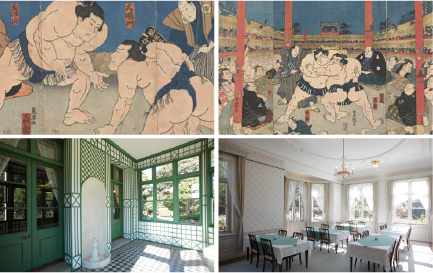
This online tour will introduce sumo‑e, or ukiyo‑e prints depicting sumo wrestlers, which are a particular highlight of the museum’s extensive ukiyo‑e collection. Sumo wrestling was considered to be one of the three major Edo (now Tokyo) amusements besides kabuki theater and the Yoshiwara pleasure quarters. During the Edo period (1603–1868), sumo wrestlers reached superstar-like status, and sumo‑e, which depicted these superstars, became a popular ukiyo‑e genre. Utagawa Toyokuni III (1786–1865) was the dominant ukiyo‑e artist of his time, and his yakusha‑e (prints of kabuki actors) and bijin‑ga (pictures of beautiful women) were in high demand during the last days of the Tokugawa Shogunate in Edo. He was also highly skilled at sumo‑e and left behind many dynamic images of sumo wrestlers’ gallant figures. In this exhibition, we introduce the sumo‑e created by Toyokuni III and other artists active during the same period, along with information about the wrestlers depicted in the prints and aspects of sumo tournaments.
In conjunction with this, we will also hold a guided tour showcasing the architectural highlights of the main building of Kyu Furukawa Tei, which was designed by British architect Josiah Conder. Conder designed the Kyu Furukawa Tei in his last years, and it is an extremely rare building that accommodates entire Japanese tatami rooms within a Western building. This building is unique as an example of Western style architecture that seamlessly incorporates elements of Japanese design and harmonizes the two styles successfully. As we walk around the interior of the building, you will be able to experience the many elaborate details that Conder integrated into the design.
Participation fee: 300 yen
Languages supported: Japanese, English
Ukiyo‑e is a form of Japanese genre art that emerged during the Edo period (1603–1868) and was widely embraced by popular culture as a medium for the masses. Our museum curator will provide an easy-to-follow explanation on how to fully enjoy and appreciate ukiyo‑e, using examples from the museum’s expansive collection.

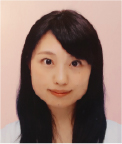
Aiko Kanematsu (Otani Museum Curator, Fujisawa Ukiyo‑e Museum Curator)
Ms. Kanematsu completed doctoral coursework for the art history program at the Graduate School of Letters, Arts and Sciences, Waseda University, without obtaining a degree. She has a master’s degree in Japanese Art History and specializes in ukiyo-e and modern Japanese art history. Major research: “A Study of the Pupils of Utagawa Toyokuni I: Utagawa Kuniyasu, Utagawa Kunimaru, and Utagawa Kuninao” published in Ōta Memorial Museum of Art Bulletin: Ukiyo-e Research, 2018; “On the Possibility of Signatures Signed on Behalf of Kunisada on Works Signed by Toyokuni I” published in The Waseda Journal of Art History, 2016 [both in Japanese].
Participation fee: 300 yen
Languages supported: Japanese, English
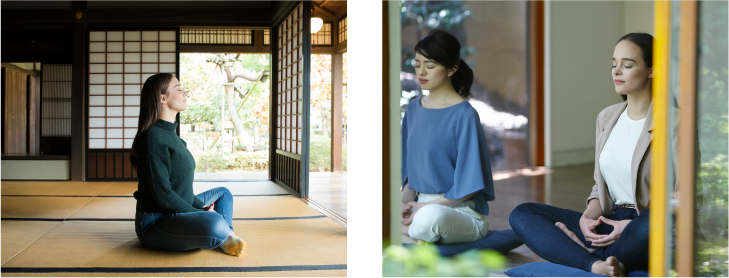
We live in an age overloaded with information and stressors that make it difficult to maintain peace of mind.
New ideas come from relaxed minds that are receptive to new information.
To reach this state, let’s empty our minds and become more open to new encounters and inspiration through the traditional Zen meditation techniques of adjusting your posture, controlling your breathing, and calming your mind.
We are happy to assist you in sitting properly for Zazen meditation so that you can experience self-reflection.
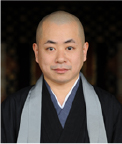
Shinsuke Hosokawa (Zen monk. Chief priest of Ryuunji Temple.)
After graduating from Bukkyo University, Rev. Hosokawa spent nine years in ascetic training at a special dojo of the Myoshinji Temple in Kyoto, which follows the Rinzai school of Zen. He assumed his current role in 2013. He is the grandson of the late Taido Matsubara, a famous monk in Japan who left behind many writings on Buddhism. Rev. Hosokawa has provided guidance on Zen Buddhism for Naotora: The Lady Warlord, and on Buddhist matters for Kirin ga Kuru (“Awaiting Kirin”), which are both NHK taiga dramas. No Need for Beliefs in Life: An Introduction to Contemplative Zen [in Japanese] is his debut work.
Participation fee: 300 yen
Languages supported: Japanese, English

Our luxury kimono are created by master artisans in Kyoto, a repository of Japanese culture and art with over 1,000 years of history. We hope that everyone can learn about Japanese culture by wearing authentic kimono that showcase the incredible skills of the artisans and value the traditions and formalities of Japan. Please take this opportunity to experience the honmamon (“genuine things” in the Kansai dialect) from Kyoto.
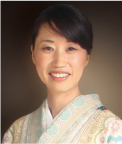
Hoshino Tsuji
Director, Kyokane Co. Ltd. / Representative and Director, Romualdo Del Bianco Foundation, Japan / Visit Kyoto Ambassador / Yamagata Special Ambassador of Tourism and Tsuyahime / Domestic Committee Member, International Council on Monuments and Sites (ICOMOS) Japan / Member, International Council of Museums (ICOM) Japan / Member, The Society of Folkloric Performing Arts
Ms. Tsuji was born into the family of a kimono store that was established in 1907. She is currently working to promote the preservation and revival of history, culture, and life rituals, cooperating with about 80 shrines and temples in the kimono rental and Japanese-style wedding planning business. In addition, she is actively engaged in efforts to hold and support international conferences for the conservation and utilization of cultural properties. As her birthplace of Kyoto and Florence, Italy, are sister cities, she works with the UNESCO advisory body ICOMOS, utilizing a network of over 500 organizations and foundations in 111 countries, to introduce local cultures and traditions to the world through her role as Visit Kyoto Ambassador and through the “Life Beyond Tourism” activities of a foundation headquartered in Italy. In 2016, she was conferred the “Lorenzo il Magnifico” Award promoted by the Accademia Internazionale Medicea, an order considered to be the First Prize sponsored by the city of Florence and the region of Tuscany, at the Hall of the Five Hundred inside the Palazzo Vecchio.
Participation fee: 300 yen
Languages supported: Japanese, English
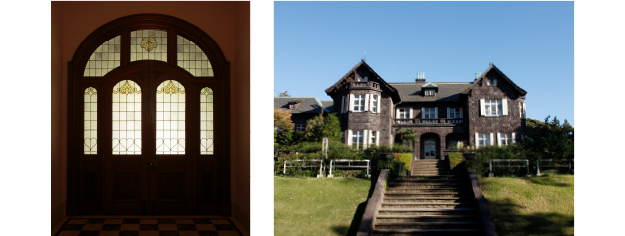
History
The museum building was commissioned to be built by Josiah Conder in 1917 as the principal residence of Toranosuke Furukawa, on the site of the former residence of Munemitsu Mutsu. It was initially used as a residence and as a place to entertain guests. The property was confiscated by the Allied General Headquarters (GHQ) after Japan’s defeat in WWII, and it remained uninhabited until it was returned to Japan three decades years later. It was designated a Cultural Property in 1982. During the 1980s, the Otani Museum undertook restoration work on the building over a period of six years with funding from the Tokyo Metropolitan Government. The museum has been open to the public since 1989.
Exterior
The building’s outer walls are constructed in ashlar masonry from reddish-black Shin-Komatsu-Ishi (andesite) obtained from Manazuru, Kanagawa. The roof is made from slate and designed in English cottage style.
Harmony of Western and Japanese styles
The first floor, where guests were welcomed, was built in the Western style, while the second floor, where the owners lived, was built in the Japanese style. Both the gardens and the interior of the building equally reflect Western and Japanese characteristics. Against the historical backdrop of Japan’s rapid Westernization following the Meiji Restoration, this residence, one of the last works of Conder’s life, aimed to find harmony between Western and Japanese cultures.
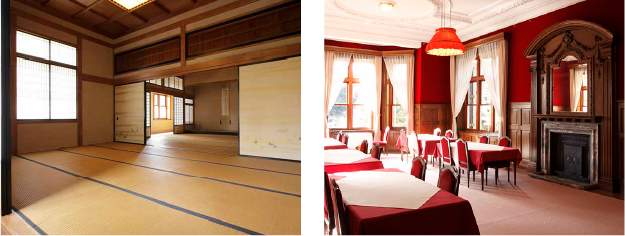
The building and Western-style garden were designed by Josiah Conder and completed in May 1917.
Following the Western-style garden, the Japanese stroll garden with a central pond was designed by Jihei Ogawa, a famous Kyoto garden master known by the name Ueji, and was completed in 1919.
The Kyu Furukawa Tei is a Cultural Property of Japan that has been nationally-designated as a Place of Scenic Beauty, as it is an extremely valuable example of a residence that preserves both the building and gardens as they appeared at the time of completion. (Designated as a Place of Scenic Beauty by the Tokyo Metropolitan Government in 1982 and as a nationally-designated Place of Scenic Beauty in 2006).
The building has a total floor area of 414 tsubo (approx. 1,370 m2), with two stories and one basement floor. It has a brick structure, wooden roof trusses and floor beams, and some steel beams. There is a skylight above the second-floor hall.
The outer walls are constructed from naturally-shaped Shin-Komatsu-Ishi (andesite) obtained from Manazuru, Kanagawa. The gable roof is covered by natural slate, while the bay windows and entrance porch roofs are covered with copper batten-seam roofing. The simple, yet stately exterior of the building is similar in style to Scottish architecture and English villa architecture.
Designed by Conder during his last years, the building features an extremely unusual floorplan that accommodates entire Japanese tatami rooms within a Western building. While the first floor consists of all Western-style rooms, used mainly for entertaining guests, all of the rooms of the second floor, except for the bedroom, are traditional Japanese tatami rooms. Rather than being an eclectic mix of Japanese and Western styles, the building’s clever configuration achieves harmony between the two styles.
This method of juxtaposing Japanese and Western styles is a major hallmark of the design, and it can also be seen in the arrangement of the gardens.
Born in England, Josiah Conder came to Japan in 1877 at the invitation of the Japanese government and became the first professor to teach at the architectural department of the Imperial College of Engineering (now the Department of Architecture, Faculty of Engineering, University of Tokyo). Among his students were Kingo Tatsuno, the designer of Tokyo Station, and Tokuma Katayama, the designer of the Akasaka Palace. Referred to as the “father of Japanese modern architecture,” Conder designed many Western-style buildings in Japan, including the Rokumeikan, Iwasaki Residence, Mitsui Club, Kaitokaku, Holy Resurrection Cathedral, and Moroto Residence. He was profoundly knowledgeable about Japanese culture and art, and contributed to many fields of Japanese culture.
Toranosuke Furukawa was a Japanese industrialist. As the actual son of Ichibei Furukawa, the founder of the Fukukawa zaibatsu (family-owned conglomerate), he became the third-generation head of the zaibatsu. He had the title of Baron. He diversified the Furukawa zaibatsu and developed it into a general conglomerate.
After graduating from the Keio Futsubu School in 1903, he studied abroad at Columbia University in New York. He was adopted by his brother-in-law, Junkichi, in January 1905, but when Junkichi died from illness at the age of 36 in December of the same year, he became the third-generation head of the Furukawa zaibatsu at a young age.
When WWI broke out in 1914, the Furukawa zaibatsu, bolstered by the wartime demand for copper, pushed forward with the diversification of its businesses. By 1918, Furukawa Gomei Kaisha (Furukawa & Co.), the holding company, had expanded into a major conglomerate with more than 20 companies under its direct control, focused on mining (Furukawa Mining), finance (Furukawa Bank), and trading (Furukawa Shoji), but also including Yokohama Rubber, Asahi Denka Kogyo (chemical), Fuji Electric, Toa Paint, Dainichi Cable, Teikoku Life Insurance, Fuji Tsushinki Manufacturing (telecommunications), Nippon Aluminium, Furukawa Shizo, Furukawa Battery, Nippon Light Metal, and Nippon Tokushu Keigokin (light alloys).
As there was no damage to his residence (now the Kyu-Furukawa Gardens and Kyu Furukawa Tei/Otani Museum) during the Great Kanto Earthquake of 1923, he opened it up to receive about 2,000 evacuees from central and lower Tokyo, and had a medical team treat the injured. In addition, he had 86 barracks built to accommodate 524 of the evacuees.
Yonetaro Otani is known for his success in the steel industry and hotel management. He helped to establish the Otani College of Technology (now Toyama Prefectural University), and in his final years, planned the Otani Museum.
Yonetaro Otani was born into a farmer’s family in Toyama Prefecture, and despite being illiterate and uneducated, he was able to start a number of businesses through persistent hard work. He moved to Tokyo by himself at the age of 30, and after working as a day laborer, sumo wrestler, and sake dealer, started his own businesses in the steel, tourism, and distribution industries, founding Otani Heavy Industry Co., the Hotel New Otani, and TOC Co., among others.
His plan to establish a museum was succeeded by the Otani Museum Foundation, which spent six years from 1983 to 1988 restoring the Kyu Furukawa Tei using a grant from the Tokyo Metropolitan Government. The museum has been open to the public since 1989.
公益財団法人 大谷美術館 〒114-0024 東京都北区西ヶ原1-27-39 旧古河庭園内
Copyright (C) Otani Museum. All Rights Reserved.